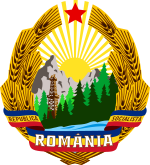| Part of a series on the |
| Socialist Republic of Romania |
|---|
 |
The Romanian rural systematization program was a social engineering program undertaken by Nicolae Ceaușescu's Romania primarily at the end of the 1980s. The legal framework for this program was established as early as 1974, but it only began in earnest in March 1988, after the Romanian authorities renounced most favoured nation status and the American human rights scrutiny which came with it. The declared aim of this program was to eliminate the differences between urban and rural, by the means of razing half of Romania's 13,000 villages and moving their residents into hundreds of new "agro-industrial centers" by 2000. The program gained notoriety in Europe, with protests from multiple countries – chiefly Hungary – as well as a Belgian-led initiative to save the Romanian villages by "adopting" them. Within a year, on 18 April 1989, the first batch of 23 new agro-industrial towns was completed. Only one new town was created between 1974 and 1988, as Ceaușescu focused his attention on other projects. Although cut short by the Romanian Revolution in December 1989, at least three more rural settlements in an advanced state of systematization were, ultimately, transformed into towns as well.